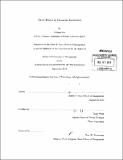Three essays in financial economics
Author(s)
Liu, Yichuan
DownloadFull printable version (11.30Mb)
Alternative title
3 essays in financial economics
Other Contributors
Sloan School of Management.
Advisor
Jiang Wang.
Terms of use
Metadata
Show full item recordAbstract
In Chapter 1, I propose that abnormal returns generated by price momentum can be explained away within the framework of an existing risk factor model such as the Fama-French three-factor model. Two features of a systematic factor, weakly positive autocorrelation and the leverage effect, generate a small positive alpha in the factor portfolio scaled by its own past returns. The momentum portfolio magnifies this alpha by taking long positions in stocks with highly positive (negative) betas and short positions in stocks with highly negative betas given a positive (negative) realized factor return. Time-varying stock betas enhance the degree of magnification significantly. I demonstrate that a simulated market in which asset returns obey the three-factor model can produce realistic momentum dynamics and substantial abnormal profits comparable to those found in the data. In empirical tests, I show that a replicating portfolio with time-varying betas accounts for 84% of the mean return and 75% of the alpha of the value-weighted momentum portfolio. Among firms larger than the NYSE median, momentum has negligible return and alpha after taking into account the dynamic replicating portfolio. Among small firms, the addition of a financial distress factor is sufficient to explain away momentum alpha. Chapter 2 confirms the idea that momentum is a dynamic portfolio of existing risk factors and suggests that momentum profit should be positive and may be justified as compensation for risk. Using select factors extracted from principal component analysis, I can construct replicating portfolios that match the equally-weighted momentum returns and even achieve a higher Sharpe ratio, whereas previous attempts based on the Fama-French factors failed to do so. Analyzing the replicating portfolio reveals that momentum derives its returns from a diverse base of existing risk factors, proportional to the amount of cross-sectional dispersion in risk premia they can explain. Momentum returns are positive because it tends to have positive loadings on stocks with positive risk premia and vice versa. The numerous and constantly changing sources of momentum profit make it unlikely that a parsimonious model of a few long-lasting risk factors can completely explain momentum; in that sense, momentum may yet be considered a quasi-risk factor. In Chapter 3, a joint work with Eung Jun Brandon Lee, we present three sets of empirical results pertaining to cross-sectional patterns in stock returns associated with various accounting ratios such as return on assets, return on equity, turnover ratios of accounts receivable and payable, and gross and net profit margins. First, we show that recent changes in these accounting ratios, rather than their levels, are responsible for large returns spreads. Second, we document "fundamental momentum", long-short portfolios formed by sorting on recent changes in these accounting ratios have significant alphas after controlling for Fama-French three-factor and Carhart four-factor models. Third, we examine the findings of Chordia and Shivakumar (2006) who conclude that the well-known price momentum effect is a manifestation of earnings momentum. We find, on the contrary, that price momentum is not fully explained nor subsumed by earnings momentum.
Description
Thesis: Ph. D., Massachusetts Institute of Technology, Sloan School of Management, 2013. Some pages printed in landscape orientation. Cataloged from PDF version of thesis. Includes bibliographical references.
Date issued
2013Department
Sloan School of ManagementPublisher
Massachusetts Institute of Technology
Keywords
Sloan School of Management.